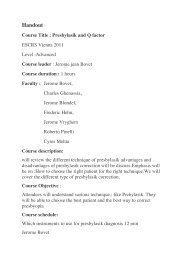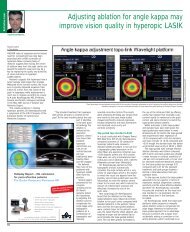ESCRS Guidelines on prevention, investigation and management of
ESCRS Guidelines on prevention, investigation and management of
ESCRS Guidelines on prevention, investigation and management of
Create successful ePaper yourself
Turn your PDF publications into a flip-book with our unique Google optimized e-Paper software.
In a case-c<strong>on</strong>trol study <strong>of</strong> post-operative endophthalmitis cases in Sweden between 1994 <strong>and</strong> 2000, Wejde et al. found<br />
that silic<strong>on</strong>e intraocular lenses carried a higher risk than heparin surface modified PMMA implants [138]. Likewise, in<br />
the prospective <str<strong>on</strong>g>ESCRS</str<strong>on</strong>g> study, the type <strong>of</strong> IOL material was found to be a risk factor which was significantly associated<br />
with endophthalmitis. Patients receiving a silic<strong>on</strong>e intraocular lens were 3.13 times more likely to experience<br />
endophthalmitis than patients receiving an acrylic (or other material) lens. The hydrophobic nature <strong>of</strong> silic<strong>on</strong>e may not<br />
be the main characteristic explaining the apparent increased risk; the explanati<strong>on</strong> is likely to be more subtle involving<br />
an underst<strong>and</strong>ing <strong>of</strong> how differing bi<strong>of</strong>ilms are formed based <strong>on</strong> the surface properties <strong>of</strong> varying types <strong>of</strong> IOLs [5].<br />
Finally, the <str<strong>on</strong>g>ESCRS</str<strong>on</strong>g> study dem<strong>on</strong>strated that surgical complicati<strong>on</strong>s c<strong>on</strong>tribute to a higher incidence <strong>of</strong> c<strong>on</strong>tracting<br />
endophthalmitis following phacoemulsificati<strong>on</strong> cataract surgery. Patients experiencing complicati<strong>on</strong>s at the time <strong>of</strong><br />
surgery had a 4.95 times higher risk <strong>of</strong> infecti<strong>on</strong> [5].<br />
There are no definite data with regard to other factors such as durati<strong>on</strong> <strong>of</strong> operati<strong>on</strong>, tissue trauma, <strong>and</strong> choice <strong>of</strong><br />
viscoelastic <strong>and</strong> irrigati<strong>on</strong> soluti<strong>on</strong> [127], while there is limited retrospective data for use <strong>of</strong> injectors for lens (IOL)<br />
implantati<strong>on</strong>, suggesting they reduce the infecti<strong>on</strong> rate [95], <strong>and</strong> operative experience, suggesting a higher complicati<strong>on</strong><br />
rate by junior staff. All these factors have been assessed prospectively in the multi-centre <str<strong>on</strong>g>ESCRS</str<strong>on</strong>g> study (Table 1.4).<br />
Because <strong>of</strong> the low incidence <strong>of</strong> childhood cataract, an exact estimate <strong>of</strong> the endophthalmitis risk in this patient<br />
populati<strong>on</strong> is not possible. In 1990, Good et al. found three cases <strong>of</strong> endophthalmitis after 671 operati<strong>on</strong>s for<br />
paediatric or c<strong>on</strong>genital cataract (0.45 per cent). Two <strong>of</strong> the three cases occurred within the first 24 hours <strong>and</strong> Grampositive<br />
bacteria were isolated as the cause (S. aureus, S. epidermidis, Strep. pneum<strong>on</strong>iae) [76]. Wheeler et al. reported<br />
11 cases <strong>of</strong> endophthalmitis after cataract surgery out <strong>of</strong> 24,000 cataract or glaucoma operati<strong>on</strong>s in children [139].<br />
Table 1.4: Risk factors for endophthalmitis following phacoemulsificati<strong>on</strong> surgery being<br />
investigated in the <str<strong>on</strong>g>ESCRS</str<strong>on</strong>g> multi-centre study<br />
Risk Factor Odds Ratio<br />
Intra-cameral injecti<strong>on</strong> <strong>of</strong> cefuroxime – given or not given 4.92<br />
Clear cornea (<strong>and</strong> positi<strong>on</strong>) versus scleral tunnel incisi<strong>on</strong> 5.88<br />
Type <strong>of</strong> wound closure – suture or sutureless no evidence found<br />
Inserti<strong>on</strong> <strong>of</strong> IOL – injector or forceps not retained as a risk factor<br />
Type <strong>of</strong> IOL material 3.13<br />
Diabetic or n<strong>on</strong>-diabetic no evidence found<br />
Immuno-suppressi<strong>on</strong> or not no evidence found<br />
Equipment sterilisati<strong>on</strong> – disposable vs reusable no evidence found<br />
Complicati<strong>on</strong>s <strong>of</strong> surgery 4.95<br />
Glaucoma surgery<br />
Early post-operative endophthalmitis following glaucoma surgery has an incidence <strong>of</strong> about 0.1 per cent [89], [142].<br />
However, the majority <strong>of</strong> cases <strong>of</strong> endophthalmitis after glaucoma surgery occur after m<strong>on</strong>ths or years; the incidence is<br />
about 0.2 per cent to 0.7 per cent [89], [142]. The risk <strong>of</strong> endophthalmitis when using anti-metabolites depends,<br />
am<strong>on</strong>g other things, <strong>on</strong> the locati<strong>on</strong> <strong>of</strong> the filter bleb, where the inferior positi<strong>on</strong> has a markedly higher risk (Wolner:<br />
three per cent with superior vs. 9.4 per cent with inferior positi<strong>on</strong>, Greenfield: 1.3 per cent with superior vs. 7.8 per<br />
cent with inferior positi<strong>on</strong>, Car<strong>on</strong>ia: 11.9 per cent with inferior positi<strong>on</strong>, Higginbotham: 1.1 per cent with superior vs. 8<br />
per cent with inferior positi<strong>on</strong>) [59], [78], [82], [142]. After 5-FU the incidence <strong>of</strong> endophthalmitis is 5.7 per cent<br />
[142].<br />
In children, six cases <strong>of</strong> endophthalmitis after glaucoma surgery were reported after 24,000 cataract <strong>and</strong> glaucoma<br />
filtering operati<strong>on</strong>s [139]. However, it is not reported how many <strong>of</strong> the 24,000 operati<strong>on</strong>s were glaucoma surgeries<br />
al<strong>on</strong>e.<br />
Endophthalmitis after filter bleb operati<strong>on</strong> commences within four weeks in about 19 per cent, so the majority <strong>of</strong> cases<br />
occur later [92], [123]. In about half <strong>of</strong> the cases, the infecti<strong>on</strong> is due to streptococci <strong>and</strong> Gram-negative bacteria<br />
including Moraxella sp. [55], [60], [181]. The endophthalmitis is sometimes preceded for days or weeks by eyebrow<br />
pain, headache, blepharitis <strong>and</strong> c<strong>on</strong>junctivitis [123]. Filter bleb infecti<strong>on</strong> can still occur after many years [60], [78],<br />
[142].<br />
5





